Evolution of U.S. Cavalry Insignia
Dragoon Cap Plate 1833-1851
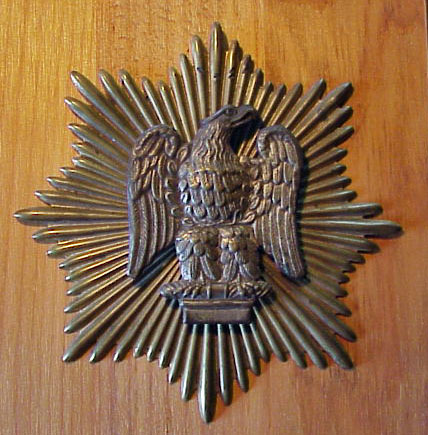
|
|
Dragoon Officer 1836
By H. Charles McBarron
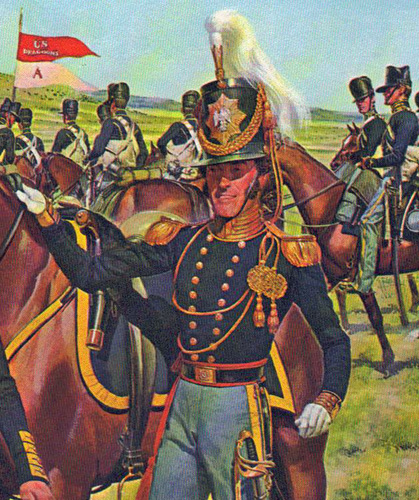
|
|
On March 2, 1833 Congress authorized the Regiment of U.S. Dragoons. The original insignia for the unit was a silver Napoleonic style eagle on a gilt sunburst that was 5 1/4 inches high. They also wore a six-pointed star insignia of a smaller size on their forage caps that were adopted in 1839 and is familiar as the signature headgear of the Mexican War period. In 1846 a Regiment of Mounted Riflemen was established. In 1850 this unit was given a perpendicular trumpet as its insignia, gold bullion embroidery for officers and brass metal for enlisted men. In 1851 the army eliminated the old dragoon cap and approved a pair of crossed sabers as the new insignia of dragoons to be worn on new style caps (shakos). In 1855 the U.S. Army created mounted units that were actually called cavalry. During the period 1858-1861 both Cavalry and Dragoons wore the crossed saber insignia. Dragoons wore the insignia in the way more familiar way oriented edge up. Cavalry wore it in a way that we might call upside down with the edge downward. In August 1861 it was decided to rename dragoons and mounted rifles as cavalry and all of them wore crossed sabers edge up. During the Civil War cavalrymen wore crossed sabers on the front of the dress (Hardee or Jeff Davis) hat and either on the top or sometimes the front of the forage cap or kepi.
Enlisted Rifles Insignia
(Courtesy: Bruce Phifer)
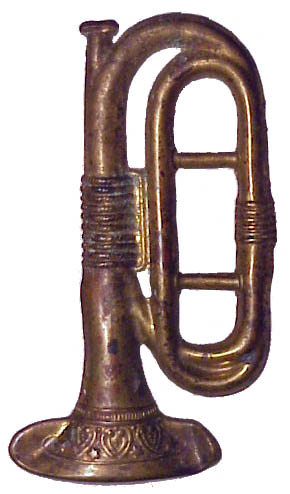
|
|
|
First Cavalry Officer's Hat Insignia 1858-1861
(Courtesy: Bruce Phifer)
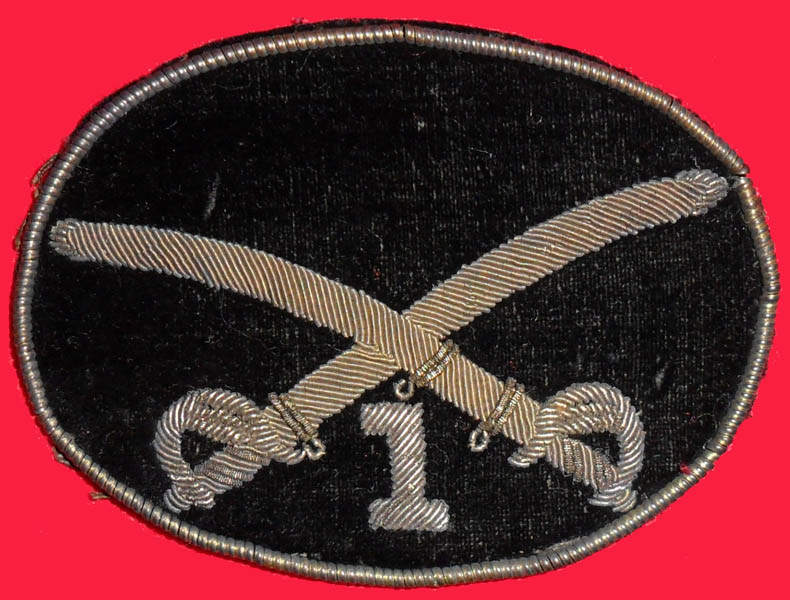
|
|
|
A officer wearing the Rifles Insignia
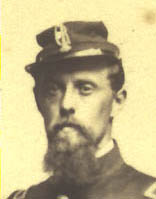
|
|
An Officer's Bullion Embroidered Hat Insignia for the 6th Cavalry Regiment 1861-1872

|
|
Civil War Enlisted Hat Insignia 1858-1872

|
|
Excavated False Embroidered Hat Insignia
This style was common pre-Civil War
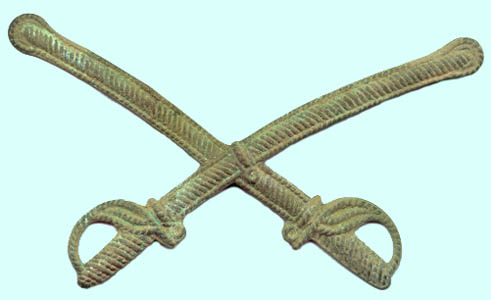
|
|
Civil War Period Cavalry Officer
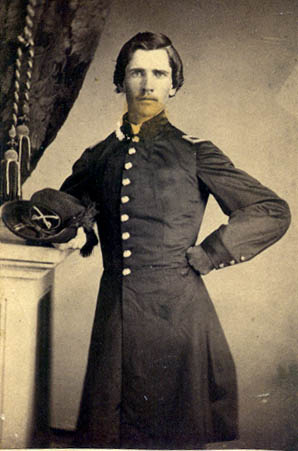
|
|
California Battalion Enlisted Man
(Courtesy: Mike Sorenson)

|
|
A trooper of the 5th Cavalry
Indian War Period
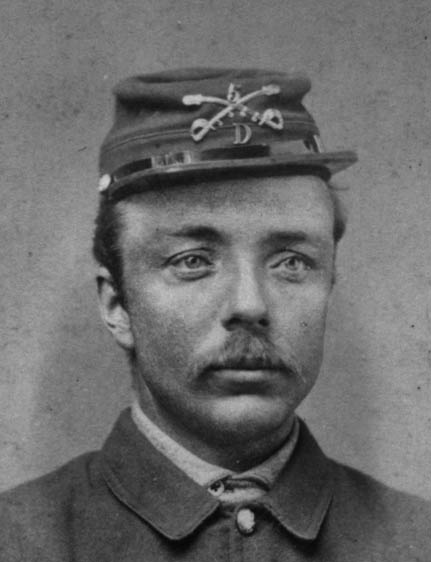
|
|
|
|
|
Forage Cap Insignia 1896-1905
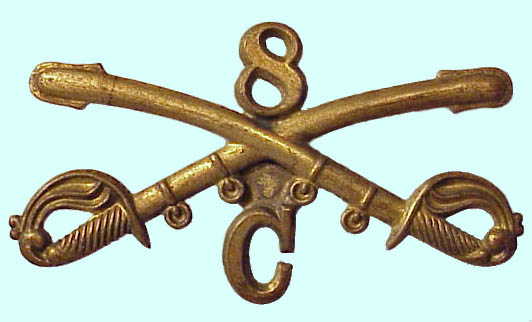
| |
In 1872 the size of the enlisted cavalry insignia was decreased and the insignia was worn on the front of the forage cap as seen in the 5th cavalry soldier. From 1881 to 1903 a cavalry dress helmet was worn and bore an eagle with crossed sabers and a shield. In 1896 a new style of enlisted hat insignia was introduced of a slightly smaller size again and with a screw post and retaining nut in the back. Prior to that time insignia were attached by loops of wire or wire prongs soldered to the back of the insignia. Officer's hat insignia continued to be embroidered crossed sabers until 1895 when the forage cap was discontinued and the arms of the United States was worn by officers of all branches. At the same time the former hat insignia was transferred to the collar in a somewhat smaller form and preceded by either a U.S. or in the case of the National Guard the initials of the state. The crossed sabers worn on Theodore Roosevelt's collar during the Spanish American War is an example. This basic formula for officer's uniforms continued up to the discontinuation of the standing collar in 1926. In the case of enlisted men it continued until collar disks were adopted in 1910. The trend was toward a smaller insignia over time.
Cavalry Enlisted Man's Dress Helmet Plate
Specification Drawing
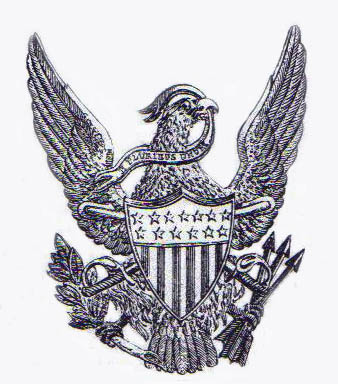
|
|
|
Theodore Roosevelt wearing Insignia of the 1st U.S. Volunteer Cavalry Regiment (Rough Riders)
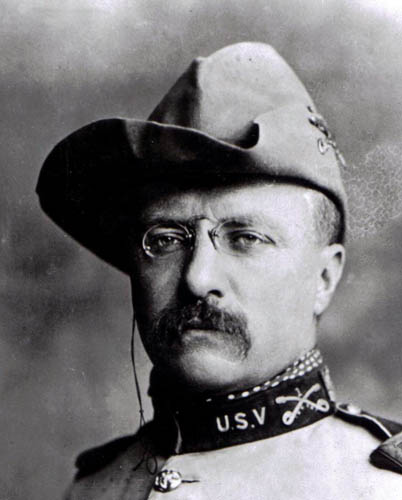
| |
8th Cavalry Officer's Collar Insignia
Turn of the Century
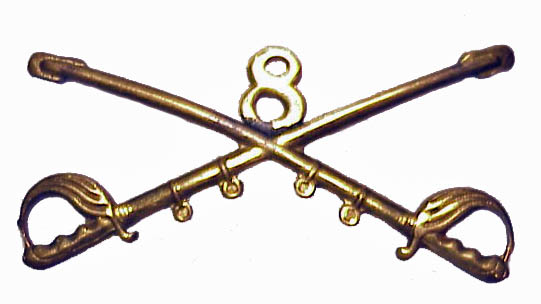
|
|
|
Back Showing Loops Used to Sew to Mohair Collar of the 1895 Uniform Coat
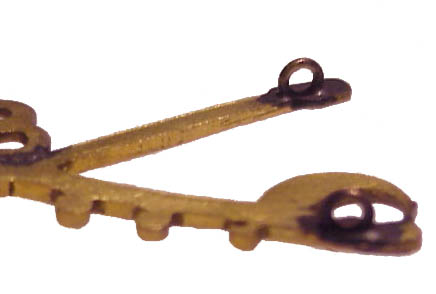
|
|
The experience of the Spanish-American War convinced the Army that subdued colors were necessary in modern war and in the early years of the 20th Century khaki summer and winter olive drab uniforms were phased in with insignia of a reduced size and in a dull bronze color. These insignia in some cases had unit designations but in other cases did not. The Army continued the blue dress uniform that is being worn by the 38th New York Cavalryman in the illustration below until World War One when it was discontinued. Insignia were often sewn on the collar using small metal loops set in the backs of the insignia.
Early 20th Century 38th New York Cavalry Trooper in dress uniform. Notice he is wearing crossed saber insignia both on his cap and collar.

|
|
7th Cavalry Officer's Collar Insignia
Early 20th Century

|
|
|
7th Cavalry Collar Enlisted Insignia
Early 20th Century
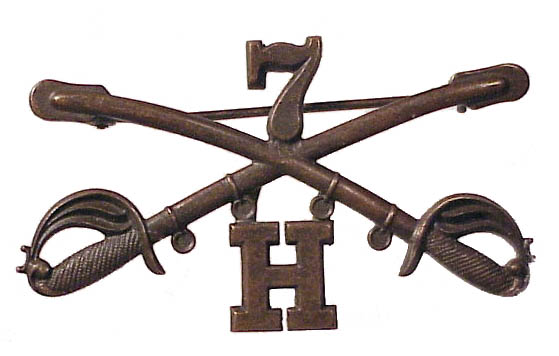
|
|
| |
Officer's Collar Insignia
World War One

|
|
Enlisted Collar Disk
World War One
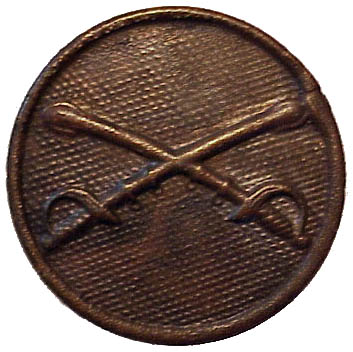
|
|
Enlisted Collar Disk Troop B, 1st Cavalry Regiment
World War One Era
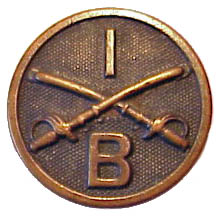
|
|
During World War One cavalry officers' insignia tended to be very thin. In 1917 branch insignia disappeared as enlisted hat insignia and enlisted men of all branches wore a circular badge with the arms of the United States. In 1924 Army uniform insignia were changed to a gilt or brass color and the dull bronze of World War One was discontinued. The saber's scabbards were thicker and the insignia dimensions were reduced. In 1926 the standing collar was discontinued and insignia moved to the lapels of the coat. The force structure included Regular Army cavalry regiments with numbers beginning with one and National Guard cavalry regiments with numbers beginning with 101. In addition there were some independent companies such as Connecticut's First Company Governor's Horse Guards illustrated below.
14th Cavalry Officer's Lapel Insignia 1930s
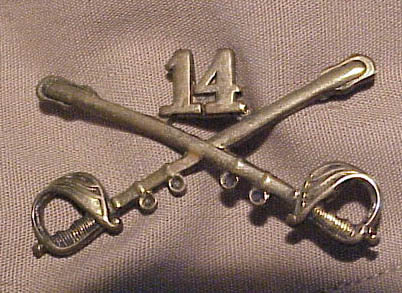
|
|
103rd Cavalry Officer's Insignia 1920s
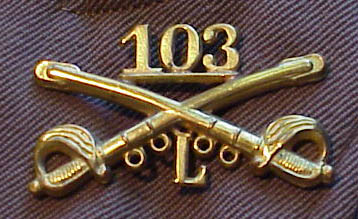
|
|
First Company Governor's Horse Guard Officer's Lapel Insignia 1930s
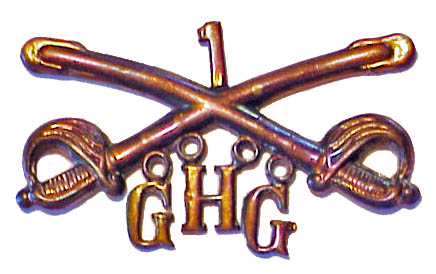
|
|
101st NY Cavalry Enlisted Collar Disk (Right Side) 1920-1930s
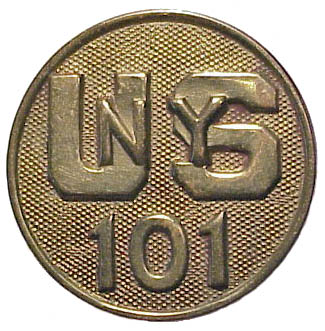
|
|
101st NY Cavalry Troop K Enlisted Collar Disk (Left Side) 1920-1930s
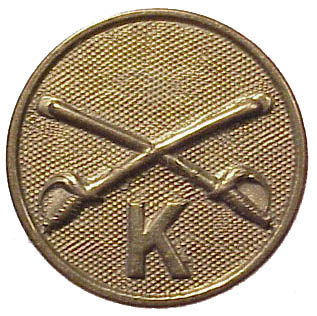
|
|
101st NY Cavalry Troop K Enlisted Collar Disk (Left Side) 1920-1930s
This disk combines regiment and company.

|
|
Cavalry Machine Gun Company
1930s-early 1940s
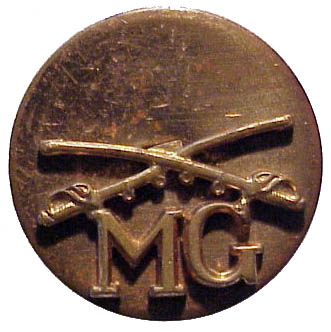
|
|
In 1939 war broke out in Europe and the U.S. Army prepared for the possible entry of the United States into the conflict. Both the German Blitzkrieg and the results of the Louisiana maneuvers accelerated mechanization and the final decision to dismount the horse cavalry. In the latter part of the war those units called cavalry were fighting as either infantry or as mechanized reconnaissance units. They still retained the traditions and the insignia of the former horse cavalry units. In 1937 the Army adopted enlisted lapel disks that were screw back and constructed of several pieces that could be disassembled for cleaning. With the huge demand for brass cartridge cases conserving brass became important and a new type of disk was introduced during the war that was one piece of thin stamped brass. This was attached using Ballou clutch fasteners, first manufactured in 1942 and illustrated below.
101st Cavalry Officer's Lapel Insignia 1930s-1940s
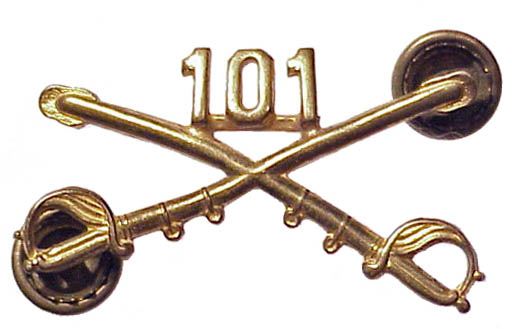
|
|
101st Cavalry Officer's Lapel Insignia 1930s-1940s
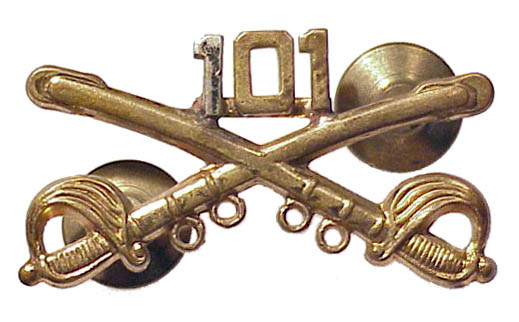
|
|
24th Cavalry Reconnaissance Squadron Officer's Lapel Insignia World War Two
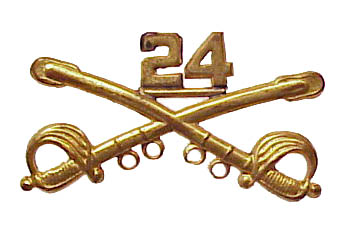
|
|
Unidentified Colonel wearing Cavalry Branch Insignia
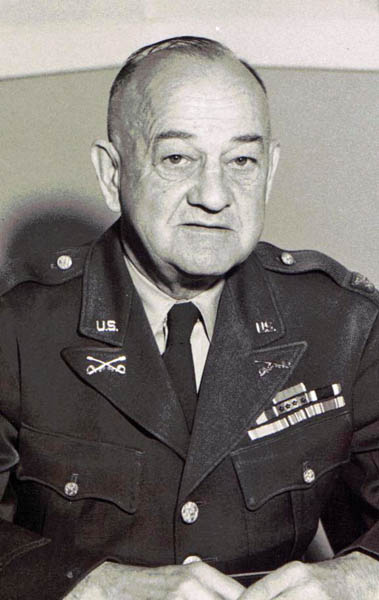
|
|
Cavalry Enlisted man's Insignia
World War Two Era
|
| 
|
|
Back showing construction and WWII Period Ballou Clutch Fasteners
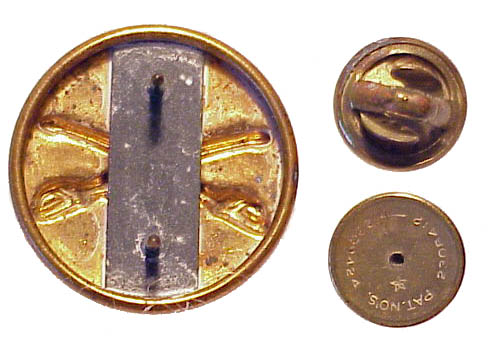
|
|
| |
In 1950 armored and cavalry forces were combined into a single branch and a new branch insignia combined the old crossed sabers with the front view of a M26 tank. In 1965 and with increased use of the helicopter in warfare the 1st Cavalry Division (Airmobile) was established. This unit began wearing the old crossed sabers insignia once again. At first the use was not officially condoned but as of 1975 their use was authorized by Army regulations.
Armored Cavalry Officer's Insignia 1950

|
Modern Cavalry Officer's Insignia
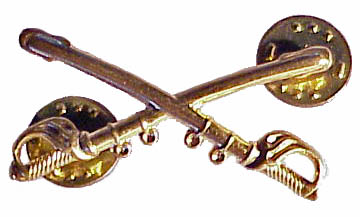
|
|
First Battalion 7th Cavalry Pile Filled Cap Insignia
Korean War Era
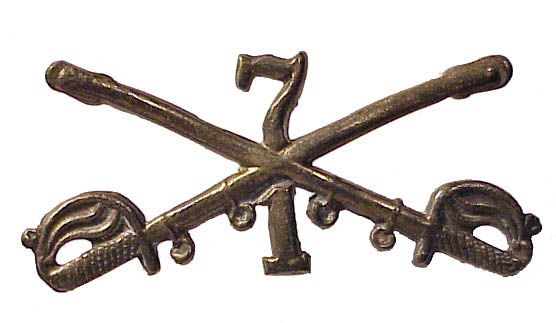
|
|
American Classic: Robert Duvall as LTC Bill Kilgore
from the Movie Apocalypse Now
"I love the smell of napalm in the morning....Smelled like... victory."
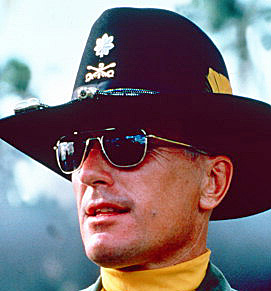
|
Thanks to William K. Emerson for his assistance with this page.
Evolution of U.S. Army Artillery Insignia
Evolution of U.S. Army Infantry Insignia
Twilight of the Horse Cavalry
Back to Discussions about Horse Related Topics
Back to Insignia of World War Two
Back to Uniforms of the Civil War
